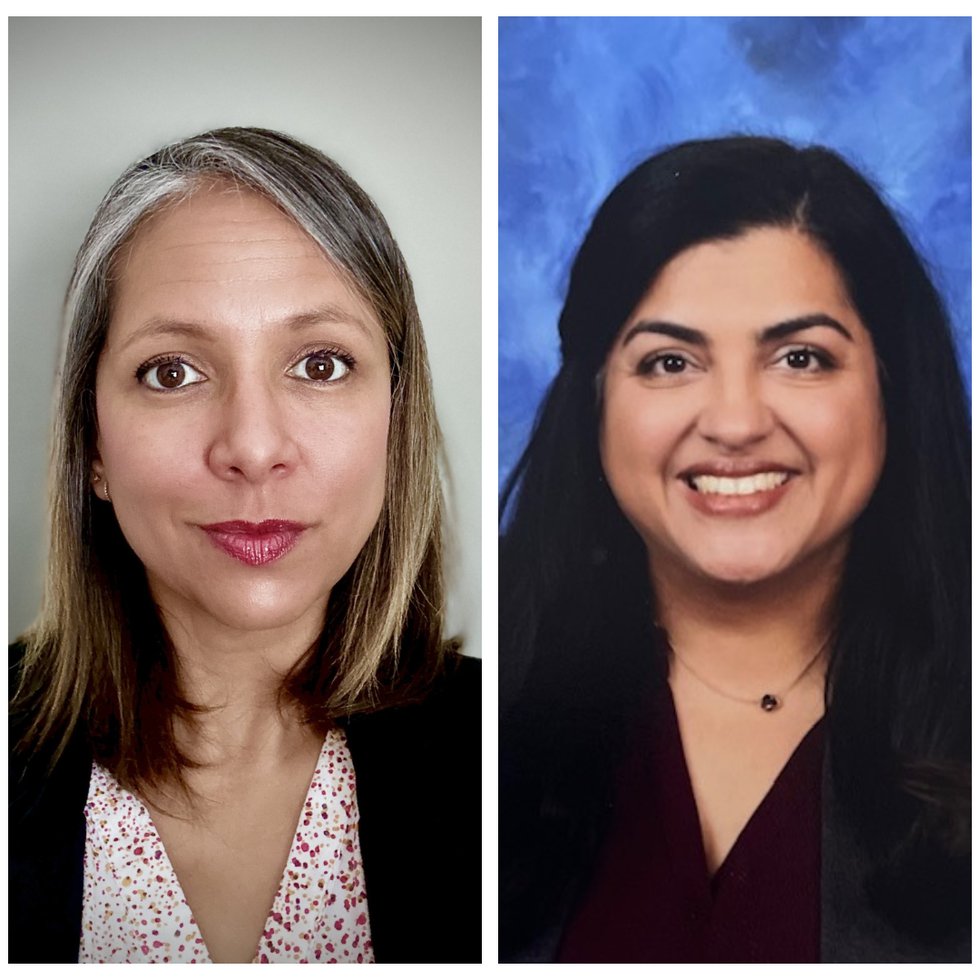Originally from Mexico City, Alejandra Dorbecker grew up with Spanish as her first language and eventually learned English and French as a teenager. After joining an international teacher certification program, she moved her family to the United States when she was 35 years old. Now, Alejandra uses her experience as a College Station Independent School District Bilingual Educational Diagnostician where she uses intelligence and academic testing to assess bilingual students for intellectual disabilities.
Margaret DeJesus decided to turn her love for language into a career after being a classroom teacher for 12 years. She is fluent in English and Spanish and has explored learning French and Italian for fun. She is currently pursuing her doctorate in Bilingual Education at Texas A&M University and serving as the Assistant Director of Bilingual/English as a Second Language/Migrant Services at Bryan Independent School District.
What are the differences in language acquisition for different ages?
Alejandra: “When you’re a child, you can learn one or two or several languages consecutively or simultaneously … The difference between learning a language when you’re younger is that your neurological pathways are being developed. Anybody, any person, when you’re in the womb, you’re exposed to language. This is why you call it your mother or native language, because that’s what you’re hearing from the womb. So the patterns and the intonation and the rhythm, the cadence, all of those things you’re being exposed to, that starts from the womb, and that starts creating different neurological pathways that are going to help you develop your own language eventually … Your baby starts receiving all this information and that’s why we develop our receptive language first … That is how language develops for everybody… And then if you wait until when you’re about to hit middle school, then your neurological pathways have already been developed. You already know the structure of your first language — and your only language at that point — so it’s kind of a shift. You have to be very into it. You have to put in an effort when you’re a little bit older because you have to kind of mold those patterns that you already know in order to bring in new information. Whereas if you’re exposed to a different language when you’re younger, it happens more naturally, and you can use that second language in your everyday life, but also for school.”
Margaret: “The first one is that there’s a lot of research that indicates that there’s a certain kind of age of maximum language acquisition that can happen. The theory behind that is that human beings between the time that they’re born to the time that they’re almost four years old — usually that sweet spot between three and four — their brains are literally sponges, because they’re acquiring knowledge, and they have a capability to acquire knowledge at such radical rates … As an adult, one of the challenges is that window has obviously passed, and therefore, our ability to learn the language, according to the research, kind of slows down a little bit because our brain stops acquiring so much information at that rate … Another big piece to acquiring the language as a child versus an adult is the sociocultural implications of it. That sociocultural pressure, to understand the language and to make a mistake freely, really plays a big role in acquiring language … We’re more willing to be helpful with children because we assume that they’re learning language. When an adult is learning a language, we don’t always have that same grace and flexibility because of our assumption that they’re already proficient in whatever language we might be learning … Language is so beautiful, and it requires your physical body to be present. It requires you seeing and hearing information and taking it in and understanding it.”
When is someone considered fluent?
Margaret: “I think amongst psycholinguists and people who study the pragmatics of language, you’re going to find a little bit of a variance in those levels … At intermediate, you are communicating in your second language, but mostly in social settings. Your academic language is still kind of hit or miss, and you need a whole lot of sheltered instruction to be able to be successful. In the end, when you get to that advanced and advanced high, your fluency level truly is where both of those, both the academic and the social setting are parallel to one another. Truthfully, it depends on what the goal for the organization is, but that’s really where the two differences lie, influencing both the merging of that social language and that academic language, and if you’re able to flow between those two registrars of language seamlessly, then that’s really when you would consider yourself fluent.”
Alejandra: “People who study languages — this is something that we see in an educational setting — will tell you that you can develop a language in BICs and CALPs. BICs are your ‘Basic Interpersonal Communication’ skills. That is what we call the social language. But if you place me in a classroom setting, that’s a different story. And those are your CALPs. That’s your ‘Cognitive Academic Language Proficiency.’ So in order for you to be considered fluent, you have to look at them separately. If you develop your social language, you can be considered fluent once you can hold a conversation at a native language and that’s it. In order for you to be considered fluent, and not only bilingual but biliterate, you need to be able to learn just as somebody [the] same age here would be able to learn in that second language.”
What are some tips and tricks to learning a second language?
Margaret: “The first thing is immerse yourself in the target language, particularly with natural and real life opportunities for practice. [For example,] if you are someone who is super tech savvy and super into social media, then surround yourself with social media and technology in the target language … I would switch all of my social media into whatever language whatever the target language is, and scroll your social media that way … The second piece is begin following and looking at different influencers and people who speak and provide reports on things that you’re into. If you’re into gardening, then find somebody who does videos and posts on gardening in Spanish, or whatever your target language is … The key is that you’re going to continue to do it.
“The next one, which may seem a little funny, but they are hold shadow conversations to train your brain on fluency patterns and word intonation … Don’t be afraid to have shadow conversations, whether you record someone or you hear someone on a podcast or you hear someone in a recording, literally repeating because what you’re doing is training your brain to catch the patterns.
“Number three, which is one of my favorite, is become a collector of new words and boost your vocabulary … In English, we have our more social registry of language, and we have our formal registry. In Spanish, the same thing exists, or in any other language, those things still exist. There’s a million different ways of expressing the same feeling or different words that mean the same thing, particularly in Spanish. So become a collector of words: ‘When would this phrase be appropriate over this phrase? Oh, I didn’t realize you said it that way. Or, I like how you said that I had never heard that before.’
“Fourth, and finally, which I think is the most important, is make it fun. As a teacher, we have to make learning a language fun. As adults, we have to make learning language for children fun. As a language learner outside of an educational setting, it still needs to be fun … And that’s why looking at things and immersing yourself in however works best for you and following people that speak to the interest that you like already works so well … Making it fun and making it related to you and something that affects you, I think is going to make your efforts that much more fruitful … From kids to adults, it’s really about expanding our current vocabulary or our current horizons, and the best way we can do that is just by having a fun conversation.”
What are some of the advantages to learning a second language?
Alejandra: “When all is said and done, and when kids hit middle school, their language usage, even in their native language, is usually way higher than that of their peers. Language usage, it’s not only about expressing yourself but understanding the world around you through language. That is one of the success predictors for people to go to college and grad school. Some people are like, ‘Oh, I’m a slow reader.’ Usually if you’re bilingual or polyglot, you’re going to be a slow reader, especially in your second or third language, but the way that you can express yourself, the way you can understand things, is probably going to be better than average … When you are a bilingual person, your neurological pathways also change. What that gives you is that you’re a person [who’s] more resourceful just throughout your general life. You become more of a problem solver because you’re always going to try to find a different way that other people that have only been exposed to a single language just don’t think of.”
What are some good resources to get started?
Margaret: “Google has the amazing ability when you do presentations, or when you’re listening to presentations, there’s an add-on that allows for you to turn on your presentations, the captions are in whatever language you set them to … If you’re completely lost, it’s definitely going to help.
“Another app that I recommend to a lot of different people is the Google Translate app — the application, not the internet software or the platform. Google Translate has the ability to have conversations. The other reason I like Google Translate is because you can take a picture and on my screen, it will have translated it to whatever language I’ve set … Is it perfect translations? No. But it’s going to allow you to understand what it is they’re trying to tell you.
“Then there’s another one that’s called SayHi [Translate], which is another application that many of our teachers use that allow[s] for some translations. All have really great benefits, and the reason translations work is because it allows for us to collect more words. The translation in and of itself isn’t a part of me learning a language — that’s simply so that I know what you just said. The other piece is for me to become a collector of the words that we just translated. Otherwise, I’m just speaking in my native language, so translations should be a very small piece of the second language acquisition process.”




